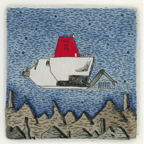 What's Happening Today - May 16
What's Happening Today - May 16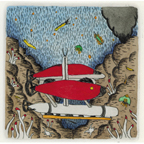
 What's Happening Today - May 16
What's Happening Today - May 16
First, an apology to all of you who have been following our cruise for the late postings for these past few days. We've been very busy with the different vehicle operations and I haven't had the chance to post a daily update and photos. From now on we'll keep posting until we get to Galápagos on May 23rd. Here goes.
Today was Hans and Maurice's first dive together. It was very productive and they spent nearly 6 hours making observations and sampling the seafloor about 1.5 kilometers from the East Pacific Rise axis. This area was where we mapped the edge of the Central Anomaly Magentic High (CAMH) on the November cruise. The following paragraph is a synopsis of their dive.
-----
Dive 3784
Science
Observers: Hans Schouten and Maurice Tivey
Alvin Pilot: Bruce Strickrott
We dove to a depth of 2539 meters (8330 feet or 1.6 miles). Our goal for the dive was to look at a small scarp that we could see on our bathymetric maps made by ABE last fall and then to sample the volcanic lavas each side of this feature. This small scarp, or fault zone, also coincides with a magnetic anomaly low, which we think indicates that the younger, more magnetized, lavas are dammed by the scarp from reaching too far from the eruption fissure. We landed in old-looking sedimented lavas and took a sample. We then proceeded west to cross the small scarp we had seen on the map. We found the scarp and noticed that is was indeed acting as a dam against which the younger lavas from the west had flowed up to and along it. We sampled these younger looking lavas. They had lots of volcanic glass on them. We then moved north along this contact zone looking for the continuation of the scarp or fault zone and also looked for obvious differences in the age of the lavas. We found several instances of young lava flows overlying older lavas and we took samples of these. For animals, we saw a small octopus, small red shrimp, sea anemones, some rattail fish and as always, brittle stars. Bruce saw a jellyfish as well. We had peanut butter and jelly sandwiches for lunch plus a chocolate bar. Our dive lasted about 6 hours on the bottom.
-Maurice Tivey
------
This afternoon we did a buoyance test for ABE to be sure that it was neutrally buoyant. Because it is an autonomous vehicle, it is important that it be neutral while surveying near the seafloor so that it does not expend extra energy keeping itself from going up or down as it travels. Rod Catanach and Phil Forte went in the water with ABE to observe how it floated or sank in preparation for tonight's first ABE dive. This evening ABE dove for the first time this cruise. The vehicle worked like a champ and ran the line it was programmed to do. This test gives us good confidence that the vehicle will work well when we send it down tomorrow and also that it will be ready to go for the next cruise on the Galapagos Rift. Be sure to check in on how ABE and Alvin are doing on Dive and Discover for Expedition 6 starting May 24 (http://www.divediscover.whoi.edu).
Today was the first time that the DeepSea Power & Light digital deep sea cameras were used on Alvin. There were a few problems but basically the images look very good. We'll continue to test them on the remaining dives on this cruise and on the Galapagos Rift dives.
The crew is helping us enormously with all the different vehicle operations - launching and recovering Alvin, ABE and the towed camera system - we couldn't do all this without their expertise and great spirit.
Best Regards,
Dan

The support boat waits as Alvin is lowered into the water (left). (right) Christina Courcier directs the launch of the CTD (conductivity, depth, temperature) system as Naomi Ward and John Heidelberg steady the tag lines. The CTD was used to collect water from the hydrothermal plume above M vent, one of the high temperature vents here at the East Pacific Rise.
Al Duester (left) in his special safety hat preparing for the ABE buoyance test. Wayne Bailey, the Bosun, in the background directs the launch of ABE for the test. Mike Doherty, foreground, tends the tag line.
Rod Catanach (left) and Phil Forte (right) jump out of the Avon to tend to ABE during the buoyance test. Jerry Graham is driving the boat and Uriel Carpentar is assisting.
The science party watching the ABE buoyance test from the starboard rail. Right photo shows Barrie Walden and Steve Liberatore (foreground) discussing the new towed camera system.
Alvin being recovered on today's dive. Eric Olson on his perch (the capstan on the fantail) as Alvin is recovered from today's dive.
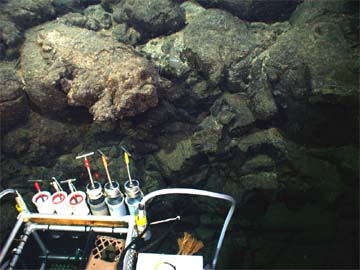
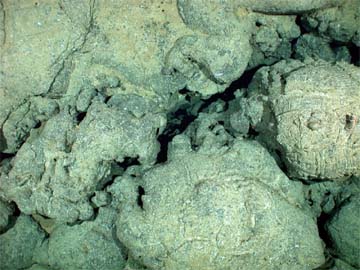
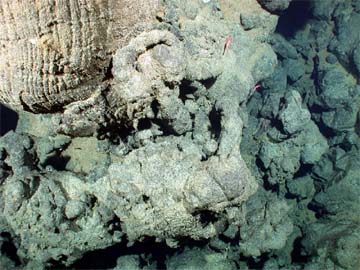
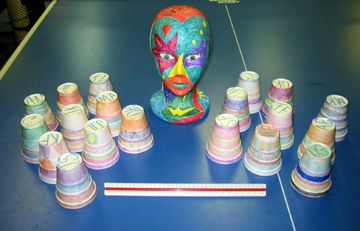
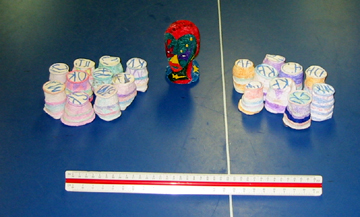
Hello to Mrs Lallys' 3rd Grade Class at Henry Wing School in Sandwich, Massachusetts from Maurice Tivey on board the research vessel Atlantis.
I took the 3rd graders Styrofoam cups out to sea with me and took
them on a dive to the bottom of the ocean using the deep diving
submarine ALVIN. I took before and after photos to show what happened
to the cups. In the before photo of the cups, I also included
a foam head that is used to display wigs.
The ruler in the photo is 1 foot long. The cups were taken down during ALVIN dive 3784 to a depth of 2539 meters (8330 feet or 1.6 miles!). That depth is equivalent to 250 times normal atmospheric pressure. In the after-dive photo, you can see the foam head and the cups have shrunk in size to almost one third their original size. All the air contained in the Styrofoam has been squeezed out permanently. This squeezing occurs from all sides so that the cups are now just small versions if the originals. I will bring the cups home with me to give back to Mrs Lally and her class. Of course I will have much more room in my luggage now.
Best wishes from the high seas of the Pacific Ocean, Maurice Tivey